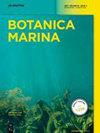产自波多黎各和加勒比海格林纳达的海蔷花属(红蔷花科)
IF 1.4
4区 生物学
Q2 MARINE & FRESHWATER BIOLOGY
引用次数: 0
摘要
摘要在加勒比海波多黎各和格林纳达的近海藻类平原上报道了一种新的潮下藻Dasya。该物种与带色素的侧鳃紧密相连,使藻类看起来蓬松,与隐斑百慕大藻有着密切的相似性和遗传亲和力,与太平洋网藻有着表面的相似性。该新物种与所有已知的大西洋同源物种以及“Dasya cryptica复合体”的非大西洋成员在基因上和在其中央周围和扩大的内层细胞中拥有根瘤方面都有所不同。本文章由计算机程序翻译,如有差异,请以英文原文为准。
Dasya hispida sp. nov. (Delesseriaceae, Rhodophyta) from Puerto Rico and Grenada, Caribbean Sea
Abstract A new subtidal species of Dasya is reported from offshore algal plains of Puerto Rico and Grenada in the Caribbean. Closely invested with pigmented lateral branchlets giving the alga a shaggy appearance, the species bears close resemblance and genetic affinity to the Bermudian Dasya cryptica and a superficial resemblance to Pacific D. anastomosans. The new species differs from all known Atlantic congeners as well as non-Atlantic members of the “Dasya cryptica complex” both genetically and in possessing rhizoids among its pericentral and enlarged inner cortical cells.
求助全文
通过发布文献求助,成功后即可免费获取论文全文。
去求助
来源期刊

Botanica Marina
生物-海洋与淡水生物学
CiteScore
4.10
自引率
4.50%
发文量
43
期刊介绍:
Botanica Marina publishes high-quality contributions from all of the disciplines of marine botany at all levels of biological organisation from subcellular to ecosystem: chemistry and applications, genomics, physiology and ecology, phylogeny and biogeography. Research involving global or interdisciplinary interest is especially welcome. Applied science papers are appreciated, particularly when they illustrate the application of emerging conceptual issues or promote developing technologies. The journal invites state-of-the art reviews dealing with recent developments in marine botany.
 求助内容:
求助内容: 应助结果提醒方式:
应助结果提醒方式:


